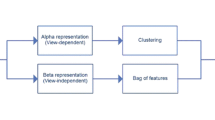Abstract
View-invariant human action recognition is a challenging research topic in computer vision. Hidden Markov Models(HMM) and their extensions have been widely used for view-invariant action recognition. However those methods are usually according to a large parameter space, requiring amounts of training data and with low classification accuracies for real application. A novel graphical structure based on HMM with multi-view transition is proposed to model the human action with viewpoint changing. The model consists of multiple sub action models, which correspond to the traditional HMM utilized to model the human action in a particular rotation viewpoint space. In the training process, the novel model can be built by connecting the sub action models between adjacent viewpoint spaces. In the recognition process, action with unknown viewpoint is recognized by using improved forward algorithm. The proposed model can not only simplify the model training process by decomposing the parameter space into multiple sub-spaces, but also improve the performance the algorithm by constraining the possible viewpoint changing. Experiment results on IXMAS dataset demonstrated that the proposed model obtains better performance than other recent view-invariant action recognition method.









Similar content being viewed by others
References
Ahmad M., Lee S (2006) Hmm-based human action recognition using multiview image sequences. In: the 18th IEEE int. conf. pattern recognition (ICPR), pp 263–266
Ashraf N, Sun C, Foroosh H (2014) View invariant action recognition using projective depth. Int J Comput Vis Image Underst 123:41–52
Bregonzio M, Gong S, Xiang T (2009) Recognising action as clouds of space-time interest points. In: the 27th IEEE conf. computer vision and pattern recognition (CVPR). USA, pp 1948–1955
Holte M, Moeslund T (2011) Human action recognition using multiple views: a comparative perspective on recent developments. In: the 2011 joint ACM workshop on human gesture and behavior understanding, pp 47–52
Ji X, Liu H (2010) Advances in view-invariant human motion analysis: a review. IEEE Trans Syst Man Cybern Part C 1:13–24
Ji X, Wang C, Li Y (2014) A view-invariant action recognition based on multi-view space hidden markov models. Int J Humanoid Rob 11(1):1–17
Junejo I, Dexter E, Laptev I, Perez P (2008) Cross-view action recognition from temporal self-similarities. In: the 10th European conf. computer vision. France, pp 293–306
Lee AR, Suk HI, Lee SW (2014) View-invariant 3D action recognition using spatiotemporal self-similarities from depth camera. In: the 22nd int. conf. pattern recognition (ICPR). Sweden, pp 501–505
Lim C, Vats E, Chan C (2015) Fuzzy human motion analysis: a review. Pattern Recogn 48(5):1773–1796
Liu J, Shah M, Kuipers B, Savarese S (2011) Cross-view action recognition via view knowledge transfer. In: the 29th IEEE conf. computer vision and pattern recognition (CVPR). USA, pp 3209–3216
Lv F, Nevatia R (2006) Recognition and segmentation of 3-d human action using hmm and multi-class adaboost. In: the 9th European conf. computer vision (ECCV). Austria, pp 359–372
Lv F, Nevatia R (2007) Single view human action recognition using key pose matching and Viterbi path searching. In: the 25th IEEE int. conf. computer vision and pattern recognition (CVPR). USA, pp 1–8
Natarajan P, Nevatia R (2008) View and scale invariant action recognition using multiview shape-flow models. In: the 26th IEEE int. conf. computer vision and pattern recognition (CVPR), pp 1–8
Niebles JC, Wang H, Feifei L (2008) Unsupervised learnling of human action categories using spatial-temporal words. Int J Comput Vis 79:299–318
Peng B, Qian G, Rajko S (2008) View-invariant full-body gesture recognition from video. In: the 19th int. conf. pattern recognition (ICPR). USA, pp 1–5
Peursum P, Venkatesh S, West G (2007) Tracking as recognition for articulated full body human motion analysis. In: the 25th IEEE int. conf. computer vision and pattern recognition (CVPR). USA, pp 1–8
Poppe R (2010) A survey on vision-based human action recognition. Image Vis Comput 28(6):976–990
Rogez G, Guerrero JJ, Martinez J, Orrite C (2006) Viewpoint independent human motion analysis in man-made environments. In: the 17th British machine vision conference (BWVC). UK, pp 659–668
Singh VK, Nevatia R (2011) Simultaneous tracking and action recognition for single actor human actions. IEEE Trans Vis Comput Graph 27(12):1115–1123
Tran D, Sorokin A (2008) Human activity recognition with metric learning. In: the 10th European conf. computer vision (ECCV). France, pp 548–561
Weinland D, Ronfard R, Boyer E (2006) Free viewpoint action recognition using motion history volumes. Comput Vis Image Underst 104(2):249–257
Weinland D, Ozuysal M, Fua P (2010) Making action recognition robust to occlusions and viewpoint changes. In: the 10th European conf. computer vision. Greece, pp 635–648
Wu X, Xu D, Duan L, Luo J (2011) Action recognition using context and appearance distribution features. In: IEEE int. conf. on computer vision and pattern recognition (CVPR). USA, pp 489–496
Wu D, Shao L (2014) Multi-max-margin support vector machine for multi-source human action recognition. Neurocomputing 127:98–103
Yan Y, Ricci E, Subramanian R, Liu GW, Sebe N (2014) Multitask linear discriminant analysis for view invariant action recognition. IEEE Trans Image Process 23(12):5599–5611
Yilmaz A, Shah M (2005) Actions sketch: a novel action representation. In: the 23th IEEE int. conf. computer vision and pattern recognition (CVPR). USA, pp 984–989
Acknowledgments
The Project supported by the National Natural Science Foundation of China No. 61103123 and the Program for Liaoning Excellent Talents in University (No. LJQ2014018).
Author information
Authors and Affiliations
Corresponding author
Rights and permissions
About this article
Cite this article
Ji, X., Ju, Z., Wang, C. et al. Multi-view transition HMMs based view-invariant human action recognition method. Multimed Tools Appl 75, 11847–11864 (2016). https://doi.org/10.1007/s11042-015-2661-y
Received:
Revised:
Accepted:
Published:
Issue Date:
DOI: https://doi.org/10.1007/s11042-015-2661-y




